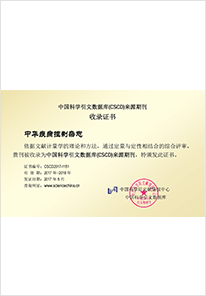2018 Vol. 22, No. 4
Display Method:
2018, 22(4): 323-325.
doi: 10.16462/j.cnki.zhjbkz.2018.04.001
Abstract:
2018, 22(4): 326-329.
doi: 10.16462/j.cnki.zhjbkz.2018.04.002
Abstract:
2018, 22(4): 330-334,362.
doi: 10.16462/j.cnki.zhjbkz.2018.04.003
Abstract:
2018, 22(4): 335-339.
doi: 10.16462/j.cnki.zhjbkz.2018.04.004
Abstract:
2018, 22(4): 340-344,353.
doi: 10.16462/j.cnki.zhjbkz.2018.04.005
Abstract:
2018, 22(4): 345-348.
doi: 10.16462/j.cnki.zhjbkz.2018.04.006
Abstract:
2018, 22(4): 349-353.
doi: 10.16462/j.cnki.zhjbkz.2018.04.007
Abstract:
2018, 22(4): 354-357,385.
doi: 10.16462/j.cnki.zhjbkz.2018.04.008
Abstract:
2018, 22(4): 358-362.
doi: 10.16462/j.cnki.zhjbkz.2018.04.009
Abstract:
2018, 22(4): 363-366.
doi: 10.16462/j.cnki.zhjbkz.2018.04.010
Abstract:
2018, 22(4): 367-370.
doi: 10.16462/j.cnki.zhjbkz.2018.04.011
Abstract:
2018, 22(4): 371-373,379.
doi: 10.16462/j.cnki.zhjbkz.2018.04.012
Abstract:
2018, 22(4): 374-379.
doi: 10.16462/j.cnki.zhjbkz.2018.04.013
Abstract:
2018, 22(4): 380-385.
doi: 10.16462/j.cnki.zhjbkz.2018.04.014
Abstract:
2018, 22(4): 386-389,410.
doi: 10.16462/j.cnki.zhjbkz.2018.04.015
Abstract:
2018, 22(4): 390-395.
doi: 10.16462/j.cnki.zhjbkz.2018.04.016
Abstract:
2018, 22(4): 396-401.
doi: 10.16462/j.cnki.zhjbkz.2018.04.017
Abstract:
2018, 22(4): 402-405.
doi: 10.16462/j.cnki.zhjbkz.2018.04.018
Abstract:
2018, 22(4): 406-410.
doi: 10.16462/j.cnki.zhjbkz.2018.04.019
Abstract:
2018, 22(4): 411-415.
doi: 10.16462/j.cnki.zhjbkz.2018.04.020
Abstract:
2018, 22(4): 416-418.
doi: 10.16462/j.cnki.zhjbkz.2018.04.021
Abstract:
2018, 22(4): 419-421.
doi: 10.16462/j.cnki.zhjbkz.2018.04.022
Abstract:
2018, 22(4): 422-425.
doi: 10.16462/j.cnki.zhjbkz.2018.04.023
Abstract:
2018, 22(4): 426-428.
doi: 10.16462/j.cnki.zhjbkz.2018.04.024
Abstract:
2018, 22(4): 429-430.
doi: 10.16462/j.cnki.zhjbkz.2018.04.025
Abstract:
2018, 22(4): 431-433.
doi: 10.16462/j.cnki.zhjbkz.2018.04.026
Abstract:


 Email alert
Email alert RSS
RSS Abstract
Abstract PDF
PDF





